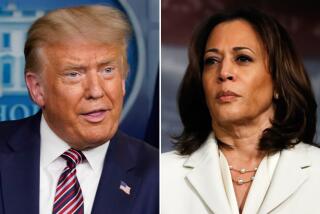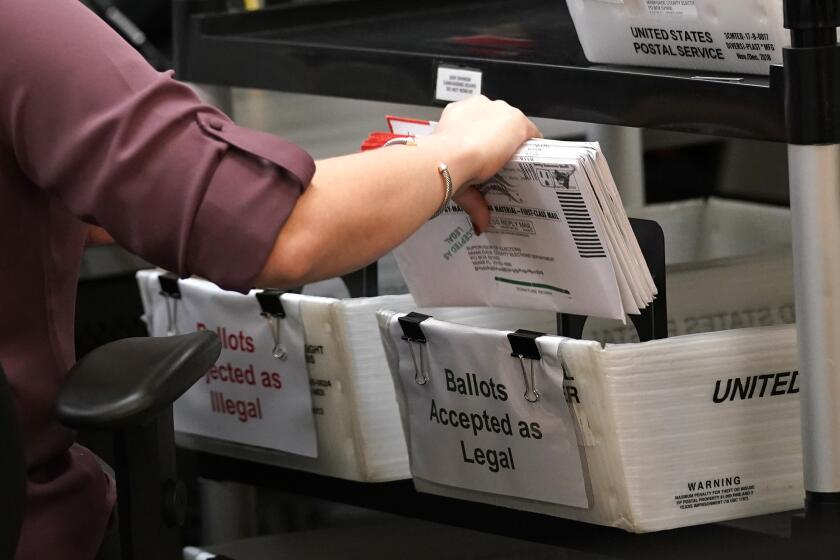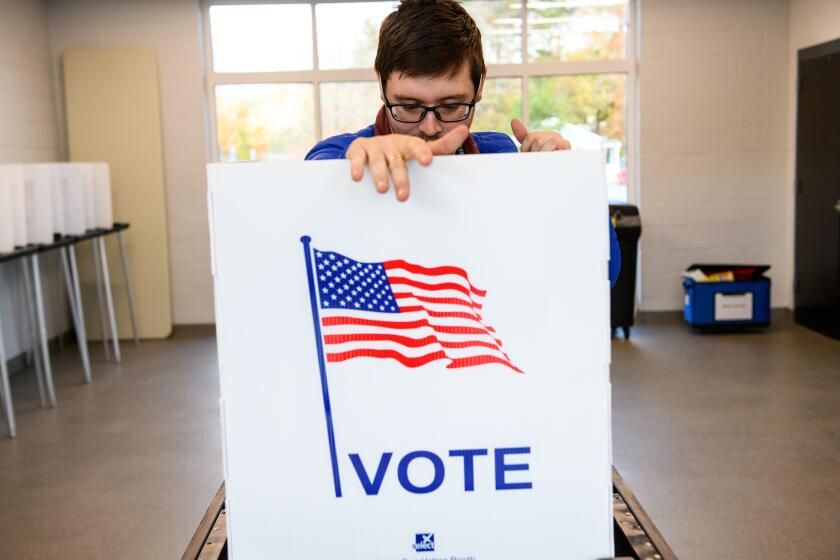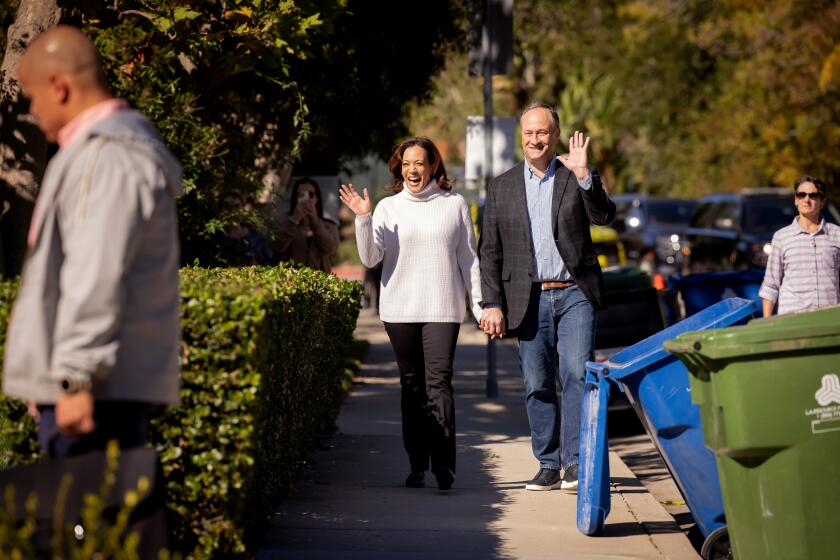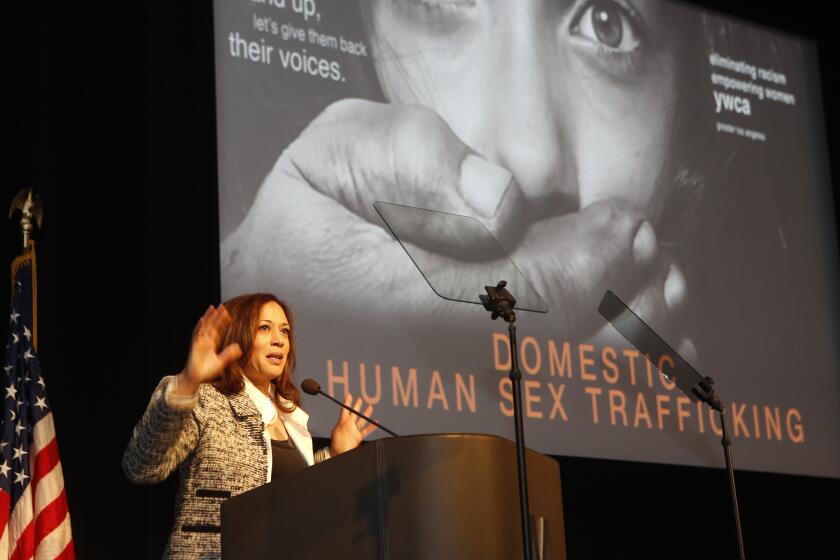Convention Cliffhangers Are Relics; Effort Now on Image Over Scrimmage
The suspense, such as it is, at national political conventions no longer takes place inside the hall. Pundits may yearn for the days when party bosses gathered to actually select the nominee, but they might as well pine for the passing of the manual typewriter; voters now have that power and they’re not giving it back. Today the national conventions have more in common with a camp reunion than a smoke-filled room.
The real suspense at conventions is how they are received outside the hall. Stripped of any decision-making authority, the conventions are still a pivotal event in the campaign year: They offer the nominee his single best opportunity to straighten his tie, shine his shoes and make his case to millions of voters who may not give him another look if they don’t like what they see Thursday night, traditionally designated for acceptance speeches.
That’s why, despite the certainty of Dole’s nomination, there is still a good bit of tension in San Diego this week. At this point, Dole is running uphill to begin with: No incumbent president with a lead as large as President Clinton’s 20-point cushion this late in the campaign has ever been caught. But if Dole can’t significantly erode Clinton’s advantage this week, his hopes of overtaking the president may be reduced to waiting for the political equivalent of a meteor strike--an outside event like an eruption of violence in Bosnia or a devastating revelation in Whitewater.
*
No politician likes to leave his fate in the hands of fate. This week may be Dole’s last chance to gain some measure of control over his destiny in November. That means amid the sushi and Wolfgang Puck pizzas, the pool parties and fireworks, the Republicans bustling by the bay are still playing for high stakes.
The good news for Dole is that candidates almost always receive a substantial “bump” in the polls during their convention. That’s also the bad news. Since both parties gain during their convention, “one can cancel the other one out,” says Fred Steeper, a Republican pollster advising the Dole campaign. “We could bounce into single digits, and they could bounce back into the kind of lead they have now.”
Most recent elections have seen the two parties battle to that kind of draw in their summer extravaganzas. Though each side briefly surged in the polls in 1976, 1980, 1984 and even 1992, the front-running candidate enjoyed about the same advantage after both conventions as he did before either.
But those numbers probably understate the impact of conventions in solidifying judgments and defining the presidential race. Disorganized, contentious conventions--like the tear-gas scented 1968 Democratic gathering in Chicago that nominated Hubert H. Humphrey III or George S. McGovern’s monument to confusion in 1972--can leave a nominee facing an insurmountable deficit.
*
Conversely, conventions that drive home a clear and compelling message can durably frame the way voters perceive a candidate through the fall. Both Clinton and George Bush demonstrated that potential. With the firm and confident language that Peggy Noonan provided for his acceptance speech in New Orleans in 1988, Bush converted his image from an inarticulate upper-crust wimp to a quiet man with hidden reserves of strength; he went from every woman’s first husband (as one wag memorably dubbed him) to Gary Cooper.
In 1992, Democrats managed a similar alchemy. Through a powerful presentation of Clinton’s biography, they transformed the public perception of him from a sharpie who glided through Georgetown, Oxford and Yale (think of Eddie Haskell with good board scores) into a small-town boy who was at once a product and the champion of “the forgotten middle class.”
Realistically, Dole can’t hope for that kind of lightning bolt in San Diego. Both Bush and Clinton arrived at their gatherings with tangible assets Dole lacks. Though still trailing in 1988, Bush had already established control of the campaign dialogue and tightened the race by indelibly stamping Democratic nominee Michael S. Dukakis as a “Harvard Yard” liberal. In 1992, Clinton was already leading and had the incomparable asset of widespread dissatisfaction with the incumbent. Dole comes to San Diego trailing badly, lacking control of the dialogue and confronting an opponent enjoying the highest job-approval ratings of his presidency.
But, like Bush and Clinton before him, Dole has a good chance of taking a first step by changing the way voters look at him this week. In the latest Times Poll, only 41% of voters said they have a favorable impression of Dole, compared to 62% who view Clinton favorably. Those numbers will almost certainly look very different by Friday. Dole’s personal story of perseverance in recovering from his injuries in World War II is compelling; the biographical video that the campaign has produced for Thursday night is bound to be moving.
Even so, it’s not clear that enhancing admiration for Dole will solve his most serious problems. In battling negative public perceptions, both Bush and Clinton had a clearly defined problem to address: weakness in one case, insincerity in the other. The coolness toward Dole, acknowledges one senior advisor, is less easily pinpointed, swirling in concerns about the Republican Congress, his age, energy and vision.
Indeed, the most vivid aspect of Dole’s personal story could even exacerbate some of his difficulties. Viewers will deservedly salute his experience in World War II, but talking about events that occurred 50 years ago (Dole was wounded in Italy before Clinton was born) does not necessarily position the Republican nominee as a leader for the new millennium.
“The Dole story has its upsides and downsides,” says White House Deputy Chief of Staff Harold M. Ickes. “Because on the one hand it is compelling, and people do look back to the verities of the past; that stands him in good stead. On the other hand, is he a man of the future? And I’m not sure that he can overcome that burden by harking back” to World War II.
Still, even before the encomiums, and the movie and Dole’s own speech, the presumptive Republican nominee has already taken a dramatic step to shake voters into giving him a second look through his selection of former Cabinet secretary Jack Kemp as his running mate.
This summer has seen Dole at some of his worst. But the Kemp selection showed Dole at his best: both pragmatic and magnanimous. Pragmatic because he reached across a 15-year history of prickly relations to pick a running mate who could help him; magnanimous because by selecting a man who had recoiled from some of the sharpest edges in the new conservative agenda (on issues such as crime, immigration and welfare), Dole sent to moderates a compelling signal of his commitment to including all elements of his party.
Watching social conservative activists inexplicably obliterate the last remnants of Bob Dole’s tolerance plank on abortion last week, Democrats felt confident that they could portray the Republican gathering as “extremist”--the same tag they hung so effectively on the Houston convention in 1992.
But by picking Kemp, Dole has probably defanged that attack--notwithstanding the demeaning Democratic efforts to label Kemp too as an extremist. (The Clinton campaign is demonstrating how dangerously addictive such incendiary language can become.)
With his choice, Dole made a stronger statement about tolerance and diversity in the party than he could ever have achieved through the platform.
Yet Dole has only taken a single step. As his advisors realize, Dole still faces devastatingly low levels of support in the center of the electorate--with conservative Democrats, independents and moderate Republicans.
What makes Kemp’s selection so fascinating is that for the past two years, Kemp has shared many of the concerns that are driving these voters away from his party. In the weeks before the GOP landslide in 1994, he publicly lamented that the Republicans were “coming dangerously close to being portrayed as [though] all we want is little government and big prisons.”
No one would pretend it’s easy to reconcile those sentiments with the dynamic conservative tide that is still the most powerful force in the party. But if Dole can’t build that bridge, he’ll continue to bleed support in the center and lose badly in November.
Every successful political coalition in American history has faced divisions; the key is finding a compelling vision that unifies and subsumes them. For Dole, a lifelong legislative tinkerer, the real challenge this week is to demonstrate that he is capable of such an expansive outlook--that he can craft a positive vision of small government conservatism Jack Kemp would applaud even if he weren’t locked arm-in-arm with the nominee at the time.
More to Read
Get the L.A. Times Politics newsletter
Deeply reported insights into legislation, politics and policy from Sacramento, Washington and beyond. In your inbox three times per week.
You may occasionally receive promotional content from the Los Angeles Times.
